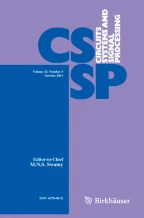Abstract
Images recognition and classification require an extraction technique of feature vectors of these images. These vectors must be invariant to the three geometric transformations: rotation, translation and scaling. Several authors used the theory of orthogonal moments to extract the feature vectors of images. Jacobi moments are orthogonal moments, which have been widely applied in imaging and pattern recognition. However, the invariance to rotation of Cartesian Jacobi moments is very difficult to obtain. In this paper, we obtain at first a set of transformed orthogonal Jacobi polynomials, called “Adapted Jacobi polynomials”. Based on these polynomials, a set of orthogonal moments is presented, named adapted Jacobi moments (AJMs). These moments are orthogonal on the rectangle \(\left[ {0, N\left] { \times } \right[0, M} \right],\) where \(N \times M\) is the size of the described image. We also provide a new series of feature vectors of images based on adapted Jacobi orthogonal invariants moments, which are a linear combination of geometric moment invariants, where the latest ones are invariant under rotation, translation and scaling of the described image. Based on k-NN algorithm, we apply a new 2D image classification system. We introduce a set of experimental tests in pattern recognition. The obtained results express the efficiency of our method. The performance of these feature vectors is compared with someones extracted from Hu, Legendre and Tchebichef invariant moments using three different 2D image databases: MPEG7-CE shape database, Columbia Object Image Library (COIL-20) database and ORL database. The results of the comparative study show the performance and superiority of our orthogonal invariant moments.
Similar content being viewed by others
References
I. Batioua, R. Benouini, K. Zenkouar, A. Zahia, E. Hakim, 3D image analysis by separable discrete orthogonal moments based on Krawtchouk and Tchebichef polynomials. Pattern Recognit. 71, 264–277 (2017)
H. Cheng, S.M. Chung, Action recognition from point cloud patches using discrete orthogonal moments. Multimed Tools Appl 77(7), 8213–8236 (2018)
Coil-20: http://www.cs.columbia.edu/cave/software/softlib/coil- 20.php.
M. El Mallahi, J. El Mekkaoui, A. Zouhri, H. Amakdouf, H. Qjidaa, Rotation Scaling and Translation Invariants of 3D Radial Shifted Legendre Moments. Int. J. Autom. Comput. 15(2), 169–180 (2018)
M. El Mallahi, A. Zouhri, J. El-Mekkaoui, H. Qjidaa, Three dimensional radial Tchebichef moment invariants for volumetric image recognition. Pattern Recognit. Image Anal. 27, 810–824 (2017)
Gábor Szegő, Orthogonal Polynomials, AMS Colloquium Publications Vol. 23, Providence, Rhode Island 2000
A. Hjouji, M. Jourhmane, J. EL-Mekkaoui, H. Qjidaa, A. EL Khalfi, Image clustering based on hermetian positive definite matrix and radial Jacobi moments. In: International Conference on Intelligent Systems and Computer Vision (ISCV), pp. 17751499 (2018)
A. Hmimid, M. Sayyouri, H. Qjidaa, Fast computation of separable two-dimensional discrete invariant moments for image classification. Pattern Recognit. 48(2), 509–521 (2015)
K.M. Hosny, Image representation using accurate orthogonal Gegenbauer moments. Pattern Recognit. Lett. 32(6), 795–804 (2011)
K.M. Hosny, New set of Gegenbauer moment invariants for pattern recognition applications. Arab J Sci Eng 3, 7097–7107 (2014)
M.K. Hu, Visual pattern recognition by moment invariants. IRE Trans. Inform. Theory 8(2), 179–187 (1962)
J.M. Keller, R.G. Michael, J.A. Givens, A fuzzy K-nearest neighbor algorithm. IEEE Trans. Syst. Man Cybern. 15(4), 580–585 (1985)
MPEG-7-CE: http://www.dabi.temple.edu/shape/mpeg7/dataset.html
R. Mukundan, S.H. Ong, P.A. Lee, Image analysis by Tchebichef moments. IEEE Trans. Image Process 10(9), 1357–1364 (2001)
ORL: http://www.cl.cam.ac.uk/research/dtg/attarchive/facedatabase. Html
G.A. Papakostas, E.G. Karakasis, D.E. Koulouriotis, Novel moment invariants for improved classification performance in computer vision applications. Pattern Recognit. 43(1), 58–68 (2010)
S. Tan, Neighbour-weighted K-nearest neighbour for unbalanced text corpus. Expert Syst. Appl. 8(4), 667–671 (2005)
M.R. Teague, Image analysis via the general theory of moments. J. Opt. Soc. Am. 70(8), 920–930 (1980)
C.H. Teh, R.T. Chin, On digital approximation of moment in invariants. Comput. Vision Graph. Image Process. 33(3), 318–326 (1986)
C.H. Teh, R.T. Chin, On image analysis by the methods of moments. IEEE Trans. Pattern Anal. Mach. Intell. 10(4), 496–513 (1988)
B. Xiao, L. Li, Y. Li, W. Li, G. Wang, Image analysis by fractional-order orthogonal moments. Inf. Sci. 382–383, 135–149 (2017)
B. Xiao, G. Wang, W. Li, Radial shifted Legendre moments for image analysis and invariant image recognition. Image Vis. Comput. 32(12), 994–1006 (2014)
J. Yang, L. Zhang, T.Y. Yan, Mellin polar coordinate moment and its affine invariance. Pattern Recognit. 85, 37–49 (2019)
P.T. Yap, R. Paramesran, S.H. Ong, Image analysis by Krawtchouk moments. IEEE Trans. Image Process. 12(1), 1367–1377 (2003)
H. Zhang, H.Z. Shu, G.N. Han, G. Coatrieu, L. Luo, J.L. Coatrieux, Blurred image recognition by Legendre moment invariants. Image Process. IEEE Trans. Image Process. 19(3), 596–611 (2010)
H. Zhu, Image representation using separable two-dimensional continuous and discrete orthogonal moments. Pattern Recognit. 45(4), 1540–1558 (2012)
Acknowledgements
The essay’s authors express their deepest gratitude to the Editor-in-Chief and other reviewers and acknowledge their valuable comments and contributions.
Funding
The authors received no specific funding for this work.
Author information
Authors and Affiliations
Corresponding author
Ethics declarations
Conflict of interest
The authors declare that the essay serves no personal or organizational interest.
Additional information
Publisher's Note
Springer Nature remains neutral with regard to jurisdictional claims in published maps and institutional affiliations.
Rights and permissions
About this article
Cite this article
Hjouji, A., Chakid, R., El-Mekkaoui, J. et al. Adapted Jacobi Orthogonal Invariant Moments for Image Representation and Recognition. Circuits Syst Signal Process 40, 2855–2882 (2021). https://doi.org/10.1007/s00034-020-01600-w
Received:
Revised:
Accepted:
Published:
Issue Date:
DOI: https://doi.org/10.1007/s00034-020-01600-w
